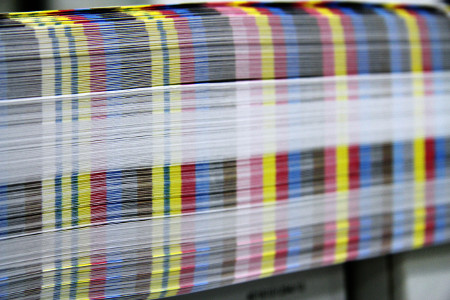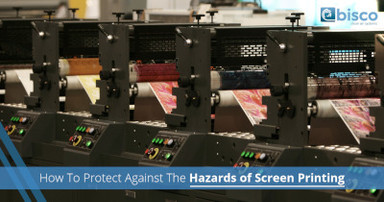Feb 28th 2018
How To Protect Against The Hazards Of Screen Printing
Print shops may seem like harmless, safe spaces for employees and employers alike, but the truth is there are actually some health hazards involved.
However, because of the causal nature of the screen printing business, many of these risks may go unnoticed.
Screen printing utilizes a variety of volatile organic compounds (VOC), including chemical solvents, inks, lacquer thinners, and much more during the printing and washing process. Exposure to the fumes emitted by common screen printing products can ultimately cause a myriad of health issues, from minor sinus irritation to respiratory problems to even cancer.
That’s why Bisco Enterprise is here to help you protect your screen printing shop as much as possible.
At Bisco, we offer industry leading fume extraction and ventilation products that are great for all industrial applications, from clearing welding and smoke fumes to collecting dust to even producing cleaner, safer air in print shops around the country.
Here are a few tips for how to protect against the hazards of screen printing.
Know Your Ink

There are several different types of ink commonly used in screen printing, each of which contains its own unique set of properties, pros, and cons.
Knowing those properties can help you protect your shop from any potential negative ramifications when it comes to your health or that of your employees.
Here are but a few examples of screen printing inks:
- Plastisol: The most common type of ink for commercial and textile printing, plastisol is known for its versatility and ability to retain its color and visibility on both dark and light colors. Plastisol is so commonly used in screen printing because it won’t dry out when left on the screen, it’s easy to work with, and it retains its visibility on fabric with proper care. However, because this type of ink is developed by essentially liquefying PVC (polyvinyl chloride), the chemical compounds within the ink may negatively react with other chemicals to create toxins when not handled properly.
- Solvent Based Inks: More commonly used for metal, glass, or plastic screen printing, solvent based inks are formulated to dry as the solvents evaporate into the air, creating a volatile and potentially hazardous work space. While practical for some applications, these solvents are often flammable and can even create respiratory issues when inhaled.
- UV Inks: Just like they sound, UV or ultraviolet inks require an intense (and potentially harmful) UV light source in order to dry. These types of inks have a strong odor, but less solvents get released into the air. However, these fast drying inks are often more toxic than other forms, plus they require other chemical compounds or solvents such as lacquer thinner to clean up, which can also be toxic and harmful to those working.
The options for ink are varied, and each presents their own challenges. When working with these types of ink in a confined space, it is crucial to enact proper safety measures in order to reduce or even eliminate health risks. Here are a few steps to take, as noted by a 2009 study performed by the Center For Disease Control and Prevention and the National Institute for Occupational Safety and Health.
What Managers Can Do
The NIOSH report found that working in a confined screen printing environment can create health hazards due to exposure to isopropyl alcohol concentrations during the printing and washing process. This is due to chemicals like solvent based ink, toluene, isopropyl alcohol, and acetone.
It was recommended that screen printing shop managers take new measures in order to protect their employees and business, such as:
- Investigate replacing solvent based screen printing inks with others alternatives that have low or no solvents.
- Provide employees with properly fitting respirators when using chemicals like inks or acetone when screen printing or screen washing.
- Provide screen printing employees with chemical protective gloves.
- Require the use of eye protection and chemical protective gloves when employees are working with chemicals, inks, and other hazardous materials.
- Provide proper storage and disposal containers for chemical compounds, lacquer thinner, and other solvents in a flammable safety area.
- Train employees on the proper procedures for disposal of chemicals or chemical soaked items, including cleaning towels which may release evaporative solvents.
- Do not permit more than a one day supply of lacquer thinner or screen inks to be stored in the same work area.
- Require the use of bonding cables to electrically connect containers of flammable or hazardous liquids when pouring from one container to another.
- Complete regular personal protective equipment training and hazard assessments.
- Implement a comprehensive respiratory protection program, including opening windows and utilizing respiratory masks when dealing with chemicals.
- Label all chemical containers with identity and hazard warning information.
- Most importantly, improve ventilation in the screen printing area.
Fume Extraction Options
The report further indicated that the leading cause of harmful solvents in the air is because there is often little to no air movement or ventilation in screen printing work spaces.
Simple fixes for this could be to simply open a window near the screen printing work area, turning on a fan at or near the window, and using proper respiratory protection.
However, there is also a better way to streamline fume extraction and make the air in these screen printing shops much safer and cleaner.
By installing a proper ventilation system, such as those offered by Bisco Enterprise, managers and business owners in Illinois and beyond can create a peaceful work environment that is free and clear of harmful fumes, solvents, and other toxins in the air.
For example, our FX extractor arms are specifically designed for use in industries, laboratories, schools, workshops, and other areas where the use of and exposure to chemicals may be prevalent.
From gluing, to working with solvents such as screen printing ink, to spot/TIG welding, and more, our extractor arms provide comprehensive fume extraction. The arms are built with anodized aluminums to protect against corrosion from solvents, and they can be mounted on ceilings, walls, floors, or tables to target and ventilate a specific work section.
In addition, Bisco Enterprise offers benchtop extraction kits which include our original extraction arms as well as a hood or nozzle, a speed control fan, and standard filter for more localized source capture, which snags pollutants at the source before they are evaporated into the air.Improving your print shop’s ventilation can drastically improve the health of your employees and business overall.
We offer over 40 years of experience in clean air systems, and ventilation in industrial work spaces is our specialty. We also offer a factory trained support system to help you set up and properly manage your system before and after purchase. Contact us to find out how we can help you today.


